Dissolved Oxygen
Dissolved Oxygen
How often does dissolved oxygen in the Great Bay and Hampton-Seabrook Estuaries fall below 5 mg/L?
Most of the time, dissolved oxygen levels remain well above 5 mg/L in the bays and open waters located at the center of the Great Bay and in Portsmouth Harbor. However, low dissolved oxygen events do occur in the Upper Piscataqua River, all the Great Bay Estuary tidal rivers, and the Hampton River in the Hampton-Seabrook Estuary. In 2021, most low dissolved oxygen events in the tidal rivers lasted between two and four hours. If these events remain sporadic and of short duration, negative impacts on aquatic organisms will likely be limited.
There were no statistically significant trends for dissolved oxygen levels in either the Great Bay (from 2005 to 2021) or Hampton-Seabrook Estuaries (from 2017 to 2021). For the Great Bay Estuary, in general, the overall trend seems to be for fewer summer days with instances of dissolved oxygen dropping below 5 mg/L than in the previous report (see Figure 9.1). For example, in the Oyster River, since 2006, the number of low dissolved oxygen days has gradually fallen. In the Squamscott River, since peaking in 2017, conditions also seem to be improving. Though less consistent, Lamprey River low dissolved oxygen days seemed to peak in 2015 and have been gradually decreasing since then.
The exception to this overall trend is the Hampton River Station in the Hampton-Seabrook Estuary, where data have been collected since 2017, and in both 2020 and 2021, there were more low dissolved oxygen days than in the previous three years.
Recently, both the Great Bay and the Upper Piscataqua River Stations remain consistently above the 5 mg/L threshold.
Another important dimension to this indicator is the duration of low dissolved oxygen events. Most recently, in the Great Bay Estuary, low dissolved oxygen events have occurred infrequently and have not lasted longer than five hours. Data indicate that the Lamprey, Oyster and Squamscott Stations have the highest number of low dissolved oxygen days in this estuary. Considering sensor dissolved oxygen data from June through September, 2021, the majority of hourly measurements in all three rivers are above 5 mg/L, but there are low dissolved oxygen events for multiple hours (Figures 9.2 – 9.4).
The insets for these time series show how many hours the dissolved oxygen was less than 5 mg/L for the lowest day on record. In the Oyster River (Figure 9.2), this day occurred on July 2, 2021, and the data show that the low dissolved oxygen event lasted for a total of eight hours. In the Squamscott River (Figure 9.3), the lowest dissolved oxygen day occurred on August 20, 2021, with two low dissolved oxygen events within the 24-hour window, each lasting about four hours.
Previous reports have noted that the Lamprey River seems to have particular dissolved oxygen problems because the tributary is less vertically mixed than other tributaries, leading to low oxygen conditions on the bottom. Given the 2017 upgrade to the Newmarket Wastewater Treatment Facility, observers hoped that there would be fewer low dissolved oxygen events; this does, in fact, seem to be happening although the trend is not statistically significant (Figure 9.1).
In August of 2015, the Lamprey River experienced a low dissolved oxygen event that lasted seven days. In contrast, the longest lasting low dissolved oxygen event in 2021 was approximately 23 hours (Figure 9.4). This pattern of shorter periods of low dissolved oxygen could signal higher water quality. However, due to the occurrence of some low dissolved oxygen events, the average dissolved oxygen values over some period of time needs to be monitored. For example, in a 2009 Chesapeake Bay report, the recommendation was to set a 7-day average at 4 mg/L.33 Experiments have shown that juvenile fishes experience increased mortality and decreased growth after as few as 8 hours of low dissolved oxygen situations.34 The impact is worse when coupled with other stressors, such as low pH.
Data for Hampton River from 2021 are concerning because of the frequency of low dissolved oxygen events (Figure 9.5). Studies indicate that frequent low dissolved oxygen events can slowly build up stress in aquatic organisms, particularly for larval or juvenile fishes.35
Acknowledgments and Credit
Easton R. White (UNH) and Wilton Burns (UNH) with contributions from Kalle Matso (PREP), Lara Martin (UNH), and Miguel Leon (UNH).
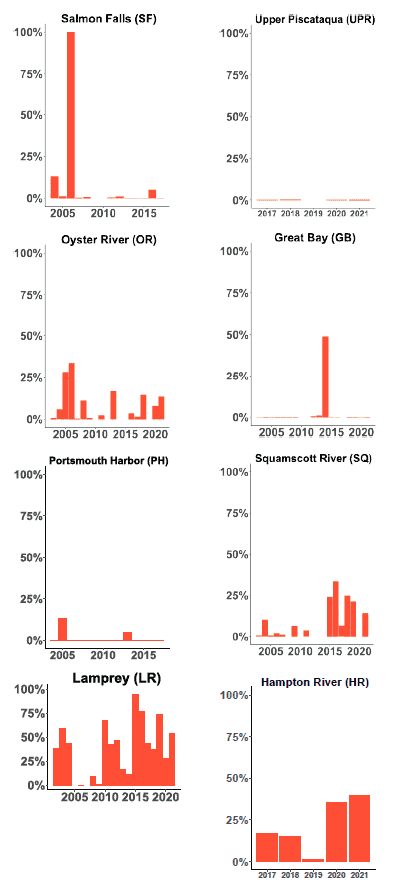
Figure 9.1: Number of summer days — the period when low dissolved oxygen (DO) events most commonly occur — when DO falls below 5 mg/L at eight sites in both the Great Bay and Hampton-Seabrook Estuaries. Data source: Jackson Estuarine Lab, UNH
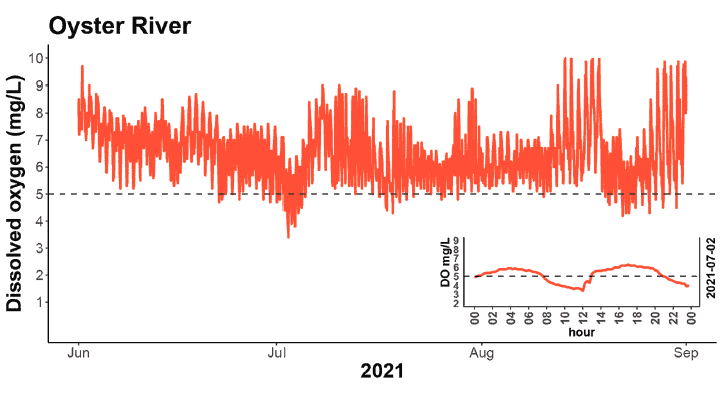
Figure 9.2: Dissolved oxygen measured every 15 minutes between June and September 2021 at Oyster River Station in the Great Bay Estuary. The smaller inset graph shows a 24-hour period on the lowest dissolved oxygen day of the Oyster River record: July 2, 2021.
Data source: Jackson Estuarine Lab, UNH
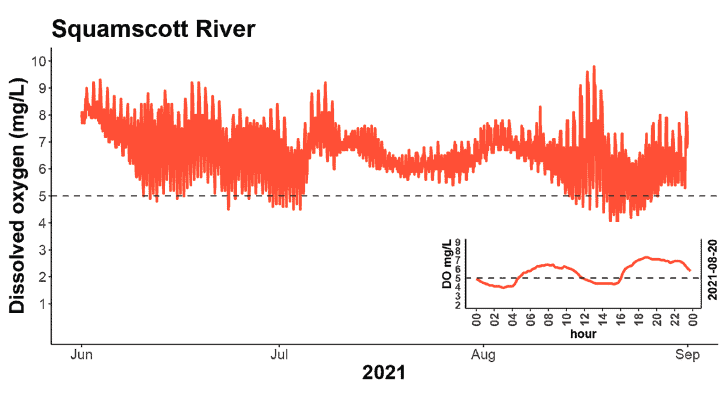
Figure 9.3: Dissolved oxygen measured every 15 minutes between June and September 2021 at the Squamscott River Station in the Great Bay Estuary. The smaller inset graph shows a 24-hour period on the lowest dissolved oxygen day of the Squamscott River record: August 20, 2021.
Data source: Jackson Estuarine Lab, UNH
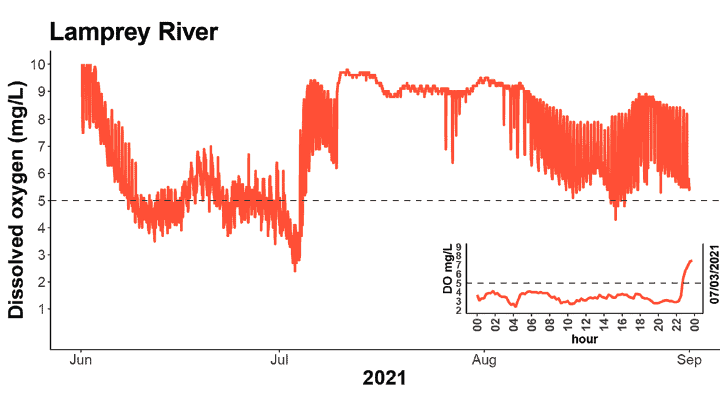
Figure 9.4: Dissolved oxygen measured every 15 minutes between June and September 2021 at the Lamprey River Station in the Great Bay Estuary. The smaller inset graph shows a 24-hour period on the lowest dissolved oxygen day of the Lamprey River record: July 3, 2021.
Data source: Jackson Estuarine Lab, UNH
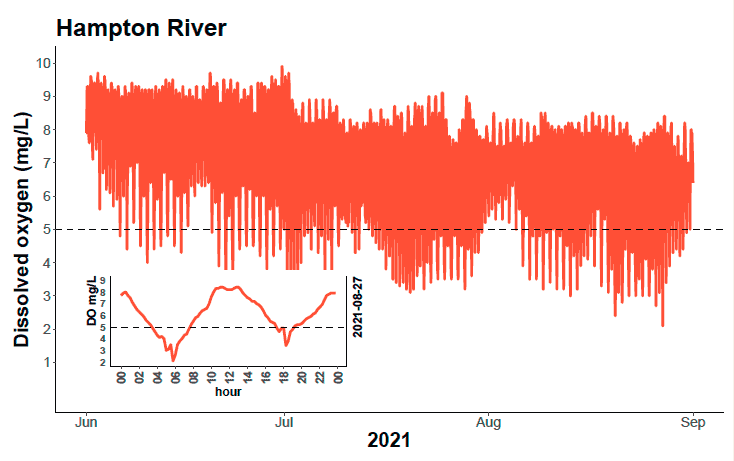
Figure 9.5: Dissolved oxygen measured every 15 minutes between June and September 2021 at the Hampton River Station in the Hampton-Seabrook Estuary. The smaller inset graph shows a 24-hour period on the lowest dissolved oxygen day of the Hampton River record: August 27, 2021.
Data source: Jackson Estuarine Lab, UNH